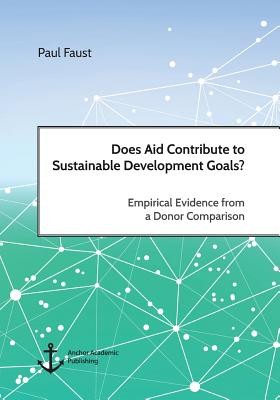
- We will send in 10–14 business days.
- Author: Paul Faust
- Publisher: Anchor Academic Publishing
- ISBN-10: 3960672160
- ISBN-13: 9783960672166
- Format: 17.8 x 25.4 x 0.5 cm, minkšti viršeliai
- Language: English
- SAVE -10% with code: EXTRA
Does Aid Contribute to Sustainable Development Goals? Empirical Evidence from a Donor Comparison (e-book) (used book) | bookbook.eu
Reviews
Description
No Poverty, Zero Hunger, Good Health, Well-being and Quality Education - these are the first priorities of the Sustainable Development Goals (SDGs) that were launched jointly by all UN Member States on January 1, 2016. The agenda of this agreement contains 17 main goals with a total of 169 targets and is dedicated to improving global living conditions and to address issues of environmental and economical sustainability with a planning horizon through to 2030. Development assistance from economically advanced countries, also referred to as aid, is one of the major means to provide financing for countries with less developed economies that face severe social problems, and which often cannot handle these problems alone. Previous studies have shown, however, that aid is ineffective and recommend comprehensive restructuring of the common aid practices. Investigations that analyse the pattern of aid flows find, moreover, that granting aid to certain recipient countries cannot only be explained by altruistic motives. They show that several strategic or non-strategic reasons have a high explanatory power for individual donor aid allocation. Against this background, the present study explores aid effectiveness of distinct bilateral donors. This is achieved by a large-scale panel data analysis applying per-capita economic growth, infant mortality and primary growth as indicators for measuring the contribution of aid to achieving the different SDGs.
EXTRA 10 % discount with code: EXTRA
The promotion ends in 21d.03:25:12
The discount code is valid when purchasing from 10 €. Discounts do not stack.
- Author: Paul Faust
- Publisher: Anchor Academic Publishing
- ISBN-10: 3960672160
- ISBN-13: 9783960672166
- Format: 17.8 x 25.4 x 0.5 cm, minkšti viršeliai
- Language: English English
No Poverty, Zero Hunger, Good Health, Well-being and Quality Education - these are the first priorities of the Sustainable Development Goals (SDGs) that were launched jointly by all UN Member States on January 1, 2016. The agenda of this agreement contains 17 main goals with a total of 169 targets and is dedicated to improving global living conditions and to address issues of environmental and economical sustainability with a planning horizon through to 2030. Development assistance from economically advanced countries, also referred to as aid, is one of the major means to provide financing for countries with less developed economies that face severe social problems, and which often cannot handle these problems alone. Previous studies have shown, however, that aid is ineffective and recommend comprehensive restructuring of the common aid practices. Investigations that analyse the pattern of aid flows find, moreover, that granting aid to certain recipient countries cannot only be explained by altruistic motives. They show that several strategic or non-strategic reasons have a high explanatory power for individual donor aid allocation. Against this background, the present study explores aid effectiveness of distinct bilateral donors. This is achieved by a large-scale panel data analysis applying per-capita economic growth, infant mortality and primary growth as indicators for measuring the contribution of aid to achieving the different SDGs.


Reviews